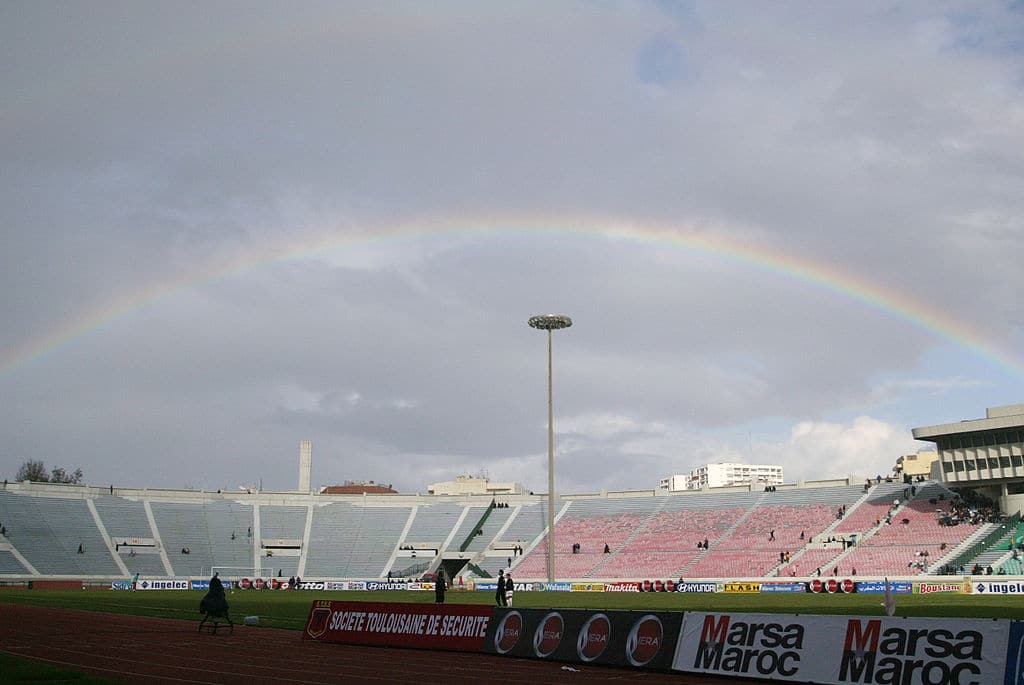The much-loved Mohammed V Stadium in Casablanca , Morocco, finds itself in the limelight as concerns about its future rise amidst plans to construct a new stadium 40km away from the city. Fans of the two local clubs are apprehensive that the historic venue might close down due to safety reasons.
Officially known as the Mohammed V Stadium, fans endearingly call it the “Donor,” referencing the “Stade d’honneur” (stadium of honour, in French), a name given to it at Morocco’s independence. Launched in 1955 in what was then the outskirts of Casablanca, today the bustling Maarif district, this 45,000-seat structure is an architectural marvel amidst its modern neighbouring buildings.
Its imposing reinforced concrete structure, the work of French architect Achille Dangleterre, is a quintessential example of the Brutalist movement. With strong ties to the city’s two clubs, Raja and Wydad, the stadium is home to at least two heated derbies per season, hailed by specialist press as among the world’s most intense football rivalries. Fans see the stadium as an integral part of Casablanca’s identity and its football culture.
However, the recently confirmed location for the new ‘great stadium of Casablanca’ in Benslimane, approximately 40km from the economic capital, has sparked confusion among fans. Social media quickly buzzed with criticism, questioning the logic of building a new stadium so far from the city.
The planned 93,000-seat project has reopened ongoing debates about the future of Mohammed V Stadium. Abdullah Abaakil, adviser for the Maarif district and city council member for the Unified Socialist Party (PSU), states, “The idea of moving the stadium is not new. But if it ends up closed and handed over to property developers, especially once the new stadium is built, it would be baffling. For the residents of popular neighbourhoods, it’s a source of integration, of which we have few in Casablanca.”
The proposal for a new stadium has been in discussion intermittently since 2008. The recent announcement came as Mohammed V underwent another round of renovations, and following the death of a female fan near the stadium on 29th April while attending a match. Official reports attribute her death to a crush caused by ticketless fans, but videos and testimonies implicate the police’s use of water cannons that day.
Casablanca Events & Animation, the company charged with managing the stadium, has been repeatedly accused of poor handling. After the events of 29th April, the company defended itself by citing the excessive number of spectators and the responsibility of clubs in deciding the number of tickets for sale.
“Matchday is a different day,” confesses Othman, 37, who spent part of his childhood living near the stadium. For residents, the hours before a game follow a set script: the area is cordoned off by the police, car movements are restricted, shops close early. Othman, who has lived in England, states emphatically, “Casablanca fans are no worse than West Ham or Millwall fans who attend their team’s matches in downtown London. The issue isn’t the location, but if a move must happen, a place within Casablanca, such as Central Quarries, should have been chosen. There is ample land available and it would have revitalised the neighbourhood.”
Mohammed V Stadium: A ‘monument’ to be ‘preserved’
So far, no official announcement has been made regarding the future of the Mohammed V Stadium. Its fate hangs in the balance, held hostage by urban planning ambitions and the aspirations of Moroccan football for a modern stadium fitting of a future World Cup host.
In 2016, clashes within the stadium led to the death of two fans. For the next two years, ultra-supporters were banned from the stadium. In 2018, the press was intrigued by the chants echoed in its stands, notably the most famous, F’bladi Dalmouni (“I suffered from injustice in my country”), protesting a lack of freedom.
The Mohammed V Stadium holds a significant place in Casablanca’s urban and football heritage. For many, its location, history, and architecture make it a monument to be preserved at all costs. As the debate about its future continues, what is certain is that whatever decision is made will profoundly affect the lives of local football fans and the city’s identity.
As the country prepares to host the 2030 World Cup, Moroccan authorities face a challenging task in balancing the need for modern football infrastructure with preserving the deep-rooted cultural identity embedded in the nation’s football history.
Image Caption: Mustapha Ennaimi / Flickr



















